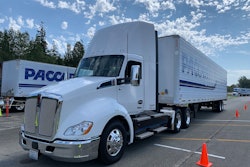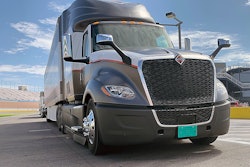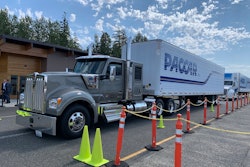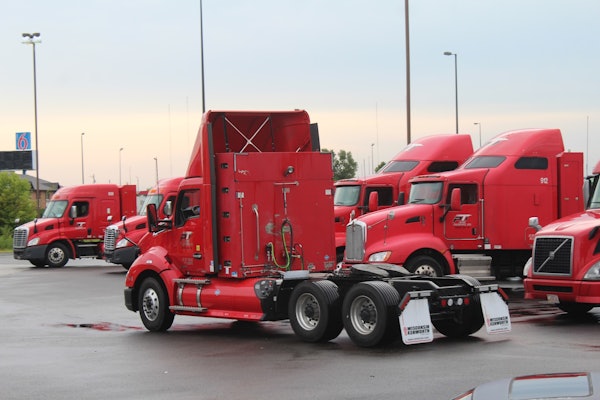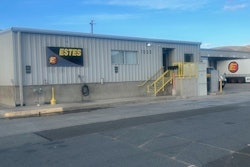Earlier this summer, CCJ Chief Editor Jason Cannon took Peterbilt's new-look Model 536 for a trip around the Denton, Texas-area. What made this model unique was its natural gas-powered engine.
Peterbilt offers two natural gas powertrain options in its medium-duty line: the Cummins B6.7N (as of March this year) and the L9N. My test truck was outfitted with the in-line six cylinder, spark-ignited, L9N for the horsepower bump. The B6.7N is rated for 200 to 240 hp and 520-560 lb-ft torque, compared to the L9N's 250 to 320 hp and 660 to 1000 lb-ft torque. My truck was spec'd to 300 hp at 2,100 RPM and 860 lb-ft torque at 1300.
In the video above, ride along with Jason and Peterbilt's Medium-duty Product Marketing Manager Phil Hall to learn more about this green-energy driving experience.
[Related: Test driving Peterbilt Model 536 with Cummins L9N natural gas engine]
Contents of this video
00:00 Peterbilt 536 CNG intro
01:51 New truck design
03:56 Interior features
09:02 New hood design
11:52 Cummins L9N natural gas engine
12:24 Headlight features
12:47 Safety and maintenance features
13:48 New hood latch design
14:21 Exterior features
15:20 Mid-year hood redesign
16:35 Test drive
23:22 Final thoughts on the Peterbilt 536 CNG
Video transcript
Jason Cannon
Hey everybody. I'm CCJ chief editor, Jason Cannon. And with me today as Phil Hall, Peterbilt's medium duty marketing manager. And behind us is a very nicely painted, very pretty, brand new Peterbilt Model 536. There's a lot of things about this truck that make it fairly unique. But one of the more substantial things about it is it's power plant. We hear a lot about electrification. We hear a lot about hydrogen and over the years, natural gas has fell by the wayside, but that's really the right now technology, as far as green, going green on the fleet side goes. Phil, tell us a little bit about the Cummins engine that's in this truck.
Phil Hall
This truck here, the model 536, has the Cummins L9 engine, which is rated at 300 horsepower at 860 foot pounds of torque. Now, Peterbilt has always been a leader in clean energy, as well as early adopters of the new technology for alternative fuels. And so we partnered up with Momentum that does the outfit. The trucks are built in our Saint T factory, brought down here in Texas and modified and outfitted with the Momentum natural gas system.
Jason Cannon
I'm getting comparable horsepower, but I'm getting an emissions reduction.
Phil Hall
Absolutely. You're getting two benefits all in one. For customers who are interested in that alternate fuel cleaner energy, they have that choice. Peterbilt's always been great in offering options for their application or for their business needs.
Jason Cannon
That this truck is brand new, it's also unique in that in the middle of last year, Peterbilt retooled its medium duty lineup and this is the byproduct of that retooling process. Phil, tell us a little bit about how this model changed for this model year versus what it might have looked like last model year and the model years prior.
Phil Hall
We not only retooled it, but we totally redesigned this whole truck from the bottom up and meaning, we started with a clean sheet of paper. We went it out to the customers to get their insights, get their information, and understand truly what their needs were. And from that, we started with the clean sheet design and built this truck from the ground up, starting with the cab here. Now, this cab may look like our 2.1 meter cab on our heavy duty, but we lower the cab by three and a half inches to the frame rail. When you do that, that's a total restructure of the cab. When it's a total restructure, that's an all new cab. The difference between this cab with the 2.1 and our predecessor at 1.9 is eight inches in difference in width. The driver now has eight additional inches of shoulder room and interior room overall. By lowering the cab by three and a half inches, you have an easier ingress and egress to and from the cab.
Phil Hall
The steps were lowered and is best in class in the industry by the first step at 15 and a half inches. Now that's with the 295 tires. Now, if you get the 19 and a half tires, that lowers it down to about eight and a half inches. It's great getting in and out of the vehicle, especially for pickup and delivery. When they're getting in and out 60 times a day, so climbing into the vehicle as you can see, it's really nice and easy. We have nice interior grab handles. The full length interior ones on the A pillar and also on the B pillar here. From the interior side, it's a lot of room in here and all the pertinent controls are within easy reach. You have your electrical switches on top here, air switch bank down here if you choose to have them. Additionally, we have the multifunction steering wheel with the vehicle controls on the left hand side, audio controls, Bluetooth and navigation through to the seven inch digital display on the right hand side. What's unique about this digital display is that the backlight is Amber color.
And that's really great for reducing eye fatigue, especially in nighttime driving. One of the other great things about this truck here is that it can customize and fit any type of driver. The seats go up and down, slide forward. They're air ride seats. Also from the steering column, full telescoping and tilt. Literally, you can float it into the position that you like, lock it in, and you're ready to go. With the B panel here, we have the brake valve that's within easy reach. And this is all in the purpose of driver ergonomics and intuitive driving. This allows the driver here to actuate the brake with ease, without putting strain on the wrist, elbows, or shoulders. The center console has plenty of storage. This takes up one cup holder so that you only get two, but if you were to get the TX8 automatic transmission, then this opens this up here with the third cup holder. Storage tray here and two USB and two 12 all power outlets. On the B panel here, this was all designed by the customer, all the customer inputs, from pickup and delivery to the vocational applications.
From class five to class eight, drivers and applications and customers, they had strong inputs of the interior. This was really a customer driven design, this whole interior and as well as the whole vehicle. Now, on the B panel here, we have a Ram out. Now what's unique about the Ram out, it is structurally mounted to the cross car beam inside the dash. And that allows for durability. This can hold up to 25 pounds. The B panel here, as you can see, they got the blank panel so they can put their additional gauges on here, but you can option for a navigation display or storage pocket that can go in here. Now from a storage volume area, this cab has the largest storage volume in the medium duty market at 6.1 cubic feet. And this storage is not only from a volume standpoint, but there's unique storage solutions. An example is on top of the dash, we have a storage tray that has reverse lip that allows for anything items that are going on top of the dash will slide back and lock in.
Additionally, header storage in here, easy cleanability and productivity. You just pop this out, wipe it down, pop it back in, and you're ready to go. There's three chamber mat pockets, enough room for small items, water bottles, and logbooks. Instead of a glove box, because glove boxes from a longevity time will rattle over time, so the customers wanted a large bin. This large bin here is designed for large items, such as flashlight, tools, small thermoses, gloves, and whatever items that the customer needs to have to do their job. Additionally, we have a large storage underneath this bench seat and it lifts up and also has access from the outside. From ergonomics and productivity, we wanted this interior to be an intuitive interior for any type of driver, for the first time driver from a rental side, if they're going to drive the truck on the weekends to the professional.
We wanted this environment here to be intuitive, also to be friendly in the sense that the driver could sit down, feel very comfortable. If they were driving a passenger vehicle, they can jump right in and the transition is done very easily. One of the cool things that we've done was we especially darkened and textured the top of the dash to reduce reflection from the sun. The texture, when the sun's shining in from the windshield, it will reflect forward. Additionally, from the interior side, from the lightings, we have this pin light here, which is amber color, and that cascades a light down onto the B panel and center console. The amber color is designed specifically again to reduce eye fatigue, especially in nighttime driving, so that way they don't have to turn on the overhead light. And once you do that, because they're bright, the eye takes about 10 seconds to adjust, especially in nighttime driving.
This pin light here solves that issue. When retrieving something down here, they do not have to turn on this light in the header. That amber pin light is on all the time. The floor sheet designed is flat. That was designed for cleanability. Especially in the lease rental market area, when the truck comes back in, the turnaround to get that truck back into service, that's one of the things is having services and areas that are easy to clean. Having a flat floor, they can just come in with air hose, blow everything out, and you're good to go. The material on the seats either it's vinyl or cloth is designed to be odor and stain resistant. Additionally, within the header as well, the header material.
Jason Cannon
Now, I had mentioned that Peterbilt retooled its medium duty lineup, but that's an ongoing process. I know that this particular model has only been available for maybe a little bit less than a year or around a year, but you guys have already introduced some changes to the hood. Phil talk us through a little bit of some of the new changes.
Phil Hall
We redesigned this hood from a continuous improvement side because Peterbilt is a big promoter of continuous improvement, not only in our production side, but also from our design development. We redesigned this arrow hood to have more of the design elements and brand image of the Peterbilt. With this hood here, we have a stainless steel grill that is standard. That promotes the durability and quality of our truck. From high impact, from rocks or ice, extremely durable with this truck. Also, the headlights in here is a halogen headlight and the performance of the halogen headlight is very, very well received from our customers. The light output and performance is extremely well, but the benefit of that for this halogen light, takes less than five minutes to replace the bulb. And I'll show you that later. The hood is three piece SMC and it comes in two lengths, 109 and 107. This ones the 109 to support the nine liter natural gas engine.
The hood pull here, it takes less than 15 pounds of pull effort. In our predecessor, our 1.9 meter hood, it was 65 pounds of pull effort. Also, the hood crown here was lowered by six and a half inches. In our old model, 337, the crown was up here about at six and a half inches higher. When lowering it down by six and a half inches, you improve the visibility by two and a half feet. With the pull effort of the hood, you can see, I can just use two fingers and I can just open up the hood. And that was the input from our service customers who do their own service on their vehicles. From back issues and everything else, we wanted to have easy service access and making their job a lot easier. And one of them things we can do is make it easy to open up the hood for those guys.
Open up the hood, as you can see, nice and easy. Also, from a safety side to promote that, we have a lock cylinder on the passenger side. It locks down, so that prevents accidental closing of the hood. All your key service points are on the driver's side, so that way it's quick and easy for the service tech to go in here. And it also promotes uptime and reduces downtime. One of the things I want to point out in here is that the air cleaner is engine mounted on top of the engine, rather than on the firewall. That reduces the in-cab interior noise tremendously. That's why when you rode in the truck, it's extremely quiet. Also, from a quick check standpoint, you can see everything is all on the driver's side, so easy access. But if you notice from a safety side, the lock cylinders on the passenger side, so what that does is it allows the service tech to do a walk around, a safety check around the vehicle before closing the hood.
We purposely designed it that way so that way, from the service side, it's promoting safety. To change out the light bulb, it takes less than five minutes. You just turn these two clips, pop that out. There's your light, give it a turn. There's your light access. You pull that out, put a new bulb in, pop it back in. You can adjust it here, put the back cap on, and then you clos her up and you're ready to go. Me walking around, I did a safety check to make sure that no one is around the vehicle. Here is the lock cylinder. Pop that up. I know no one's around the vehicle, so the truck is ready for it to be put back together. When I close the hood, again, 15 pounds. I can use two fingers and very little effort putting it down. Nice and easy and smooth.
Also, from the bumper standpoint, this is a composite painted bumper. We do offer an arrow three piece stainless steel bumper with a three piece that has breakaway features right here. That way, if the corners get hit, which happens often in a pick up and delivery scenario, then you just loosen up four bolts, put the bumper back in place and you're off and ready to go. From a vocational side, we do offer a channel style bumper for those vocational applications. The design of this latch, we did probably about five different designs because we wanted to get it perfect and right. One of the things from the customer input was they're always busting up their knuckles. It's hard to do it with gloves or when there's snow and different weather conditions. We wanted to make it easy, but also safe. To latch it, literally, simple two fingers down, you're done.
Little things like that makes a big difference from a customer satisfaction, also, from the quality and durability of the Peterbilt. With the stair style steps, like I mentioned before, easy ingress and egress. The other cool thing about this whole cab is that the mirrors are cab mounted rather than on a door. And that is to promote durability of the truck. The benefit of that, if it was mounted on the door, every time the door opens and closes, it's causing wear and tear on the wires. Here, mounting it on the cab, it's more structurally reliable, because it's mounted to the structure. Additionally, it improves the visibility down the side of the truck. Also, from a wind noise and the cab interior noise is extremely quiet. That is done because of this wind vein in here on the windows. This is an anti soiling, but also it breaks up the wind, so the cab noise inside is very quiet. Even when you're driving 65 miles an hour with the windows down, it doesn't cause a turbulence inside the cab. It has two features of this wind vein in here.
Jason Cannon
I mentioned earlier that Peterbilt redefined, retooled its medium duty lineup earlier last year, but that ongoing process has resulted in maybe a mid model year retooling of the hood. We've come outside to a different model that has a newer model hood. And Phil, tell us a little bit about the hood we showcased on the truck inside versus the hood we have here.
Phil Hall
Sure. As you can see, it's really showing the brand image of the Peterbilt. And what's unique about the Peterbilt's hoods is a signature fender valley that's depicted here. Also, the hood side feature, very strong, very elegant, also accentuates the hood length and overall design and design language of the Peterbilt. Also, from a Peterbilt hood side is that we have dual side air intakes, not only from a performance, but also from aesthetics and brand imaging.
Jason Cannon
Hey, thanks Phil for a great walk around.
Phil Hall
Absolutely.
Jason Cannon:
You probably noticed we are absent a 26 foot box. That'll be outfitted a little bit later. Right now, the only thing we're hauling is air and C&G, but it's almost 100 degrees out here. Phil, you latched the hood, right?
Phil Hall
I did.
Jason Cannon
Is the air conditioner on?
Phil Hall
AC is on and running.
Jason Cannon
Let's hop in and go for a ride.
Phil Hall
Let's do it.
Jason Cannon
What's the difference between, well, this is an L9, so what's the difference between a B67N and an L9 customer?
Phil Hall
Well, I think it's based on the payload of what they're going to be carrying. If you need a little bit more horsepower or where it's operating from a terrain standpoint, you want a little bit more juice and power, the nine liter gets up to about 320 horsepower versus the B6.7, it peaks out about, what, 285 I think. It all depends on the customer and what they need it for, for what type of payload. This one is set up, it's a nine liter. They're going to be carrying up various types of loads. It could be light loads to heavy loads in the back of the 26 foot van box. But if you have very specific loads that are consistent and that's not going to change, then they'll probably go with the seven liter or 6.7 liter. I think with the L9, it gives you a little bit more versatility of what type of payload you can carry.
An example would be a customer who get a 6.7 liter net gas would be a customer who carries, I don't know, potato chips. That's all they're going to be carrying. And that's primary use. They don't need an nine liter, but parcel carriers or whatever, they may be carrying a piano in the back or specialty logistics for medical equipment to light parcels, then you probably want to L9. And if it's going to be operating in big terrains, I don't know, Seattle area or Colorado, that they need a little bit more horsepower getting up the mountains or so.
Jason Cannon
From a pedal feel and sound and driver experience standpoint, I don't know that I would know this was a C&T engine, unless you told me. It doesn't feel ant different, it doesn't sound any different.
Phil Hall
Yeah. The drivability of it, everything, the behavior of it as well, it operates like a diesel. I think that's one of the cool things that Cummins did that did a good job of mimicking the diesel from a horsepower torque range. Just from the outside appearance, when you walk up to it and seeing the side tanks, that's when you can pretty much tell if it's a CNG. Well, the thing that's cool about it when we designed this interior, we put a methane detector up in here as well. When they do get CNG, the detector's right inside there. Now, the sun's right here. You notice the top of the dash, the reflection's heading that way. It's not into your eyes. The top of the dash was textured and the angle of the dash is to reflect light and diffuse the light so it doesn't go into the driver's eyes. A lot of little things we incorporated in the design of this truck. Our trucks were designed to last multiple life cycles.
One of the great things that we wanted to carry forward from our durability side and versatility from our 1.9 is that we've been building medium duties since 1995. And those vehicles built since then till now, 95% of them are still in service. We want to carry that heritage into this vehicle here from a durability and versatility side. With that, this truck from a structure standpoint, designed to last five life cycles, and that's really good from a residual value. And I think that's why we hold very strong in the after sales market and a resale market. Now, from a versatility side, we offer two different types of arrow hoods a 107, 109. You can get a low horsepower, nine liter diesel engine in a 107 BBC, which is pretty phenomenal. And then also, we're coming out with our Fepto hood to expand our capability in the vocational market. And that has the stationary grill. That's 109 BBC.
It has a 24 inch bumper extension with fall through rails and a stationary grill, so snow plows or tanker applications, anything that requires a front end equipment provision, that hood and that outfit will be really good for that type of application there. And what's cool about this it has the Bendix collision mitigation system is fully integrated into the digital display. The side sensor, you'll hear it through the audio system. And also from a collision avoidance, it will apply the brakes if the vehicle's getting too close to an object. There's no peep hole down below on the door here, but we have the look down mirror, so combination with the look down mirror, that's standard, and then if you get the side sensor, then it's really safe change your lanes on when you're... You're talking about nat gas, we're seeing a lot in the refuse business as well, especially right. And part of it is because sometimes they make their own fuels from that. Or also they have dedicated routes. I think there's a formula for it.
And if you know your routes, and if you have the infrastructure in place from a refueling side and your trucks are being serviced within, I'm going to say, 25 mile radius or so, operating in 25 mile radius like refuse trucks or whatever, you're going to see a lot of CNGs. The cab is air ride and seats or air ride seats with air suspension in the cab and then 23K air leaf suspension on the rear tires.
Jason Cannon
It's unique in that the power plan of this truck is different, but you don't really know it.
Phil Hall
Especially in the pickup and delivery stop and goes and stuff like that.
Jason Cannon
It might be a little bit quieter now, but when you're getting into it, it's really pulling a lot of power, sounds exactly how you'd expect it to sound. Neutral, pull the air brake, and I guess as a recap goes, it's just a truck man. It's a medium duty truck. It has a natural gas, nine liter engine in it that if you hadn't have told me that it was a natural gas nine-
Phil Hall
You wouldn't know the difference. Huh?
Jason Cannon
Wouldn't have known any difference. Great visibility. I think that's a home run. I can't even see the end of the hood. Easy to navigate through. Left hand turns, right hand turns couldn't have been any easier.
Phil Hall
And if you notice, the interior is very truck pickup truck like. And that's what we really wanted to have this interior to be very intuitive for any type of driver, the first time drivers to the professional. It meets all those needs from a customer base. And from a class five and six pick them delivered too, the baby eights vocational heavy duty applications this dash will accommodate for that for their equipment and for their use. If you notice a lot of things are easily reach locations of your switches, knobs, and all that. And from a visibility standpoint, everything is where it ought to be. It's very intuitive interior and we've been very successful with it. And the credit goes to the customers because this interior layout was done by the customers. And I think that's one of the great things that when we designed and develop this vehicle, we didn't go based on our expertise. We enhance our skillsets with the customer input. And so the customers really drove the design of this vehicle and we thank them for it.
Jason Cannon
I would agree with that. It really does have an automotive type feel. It's utilitarian, but everything is about where you would expect it to be, the buttons on the dash, the buttons on the wheel, the gauges on the instrument cluster. They're all about where you would expect. If you don't drive this truck every day, maybe you drive a super duty, maybe you're in a step side van, something like that, you come in here and you, oh, okay. Well that's about where I would expect this particular button to be. Radio controls, your cruise control, it all makes sense.
Phil Hall
Yep. Yep. One of the design themes that we wanted to promote was productivity of the driver, not only of the truck and vehicle from a performance standpoint, but also the guy who's going to be driving it, the guy who's going to be servicing it. Day in, day out, we wanted them to be productive and efficient as much as possible. And so we incorporated all those elements into this design of this vehicle and we're not done yet. We still got things going on in the background. There are going to be some more future improvements on this and in development. We're excited about it. This truck is here to stay. And I think being part of the design team of this vehicle here, when I worked in the design studio, we wanted to redefine what a medium duty ought to be and literally designed the ultimate medium duty truck. And I think we've been pretty successful with it. And there's more to come, definitely more to come.
Jason Cannon
Well, if this is not the ultimate, it's a contender.
Phil Hall
Yeah, definitely it is. Thanks.




